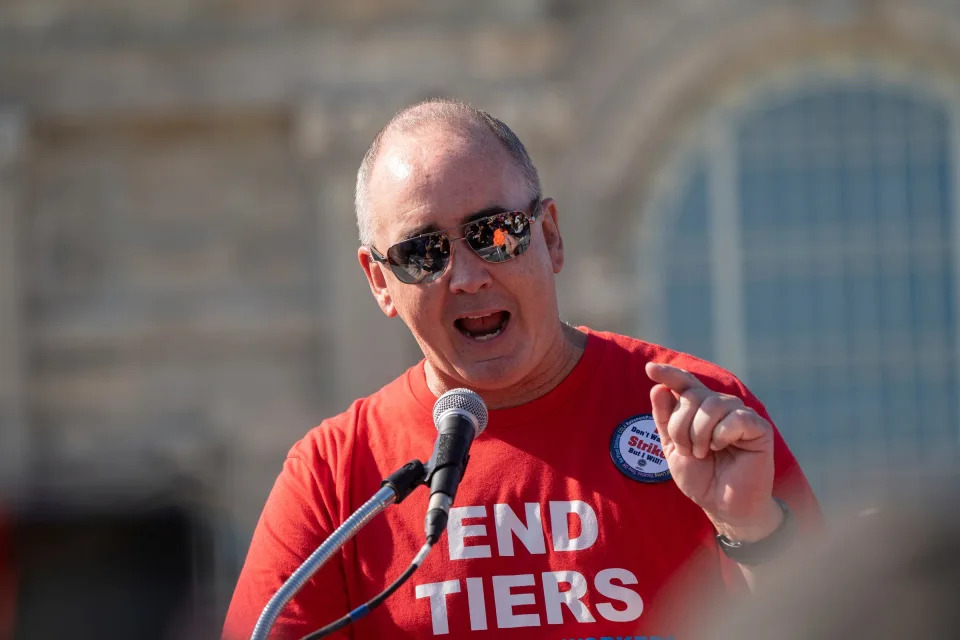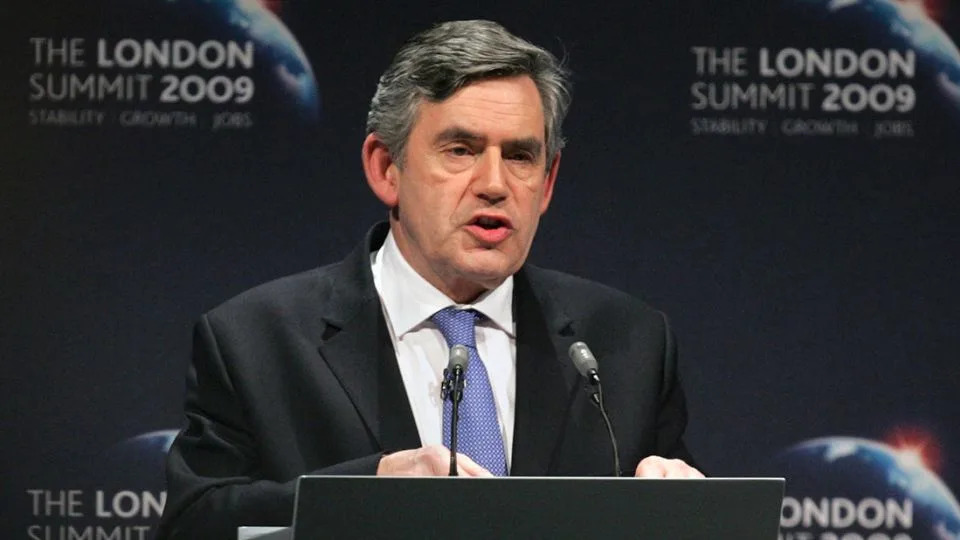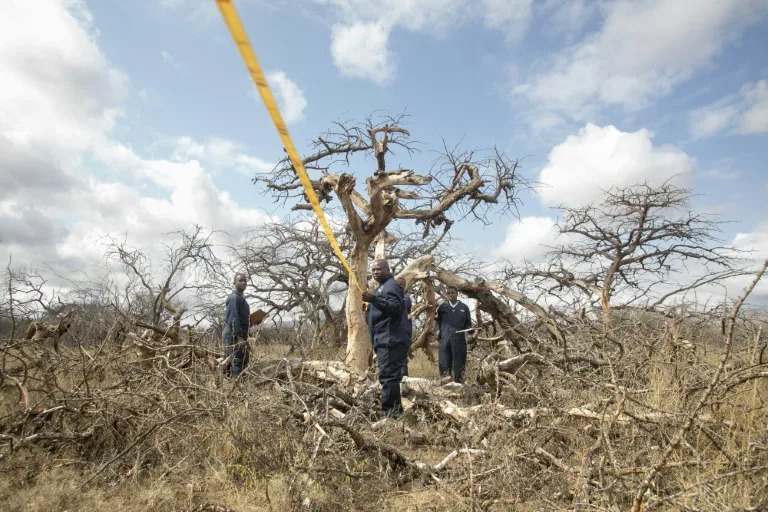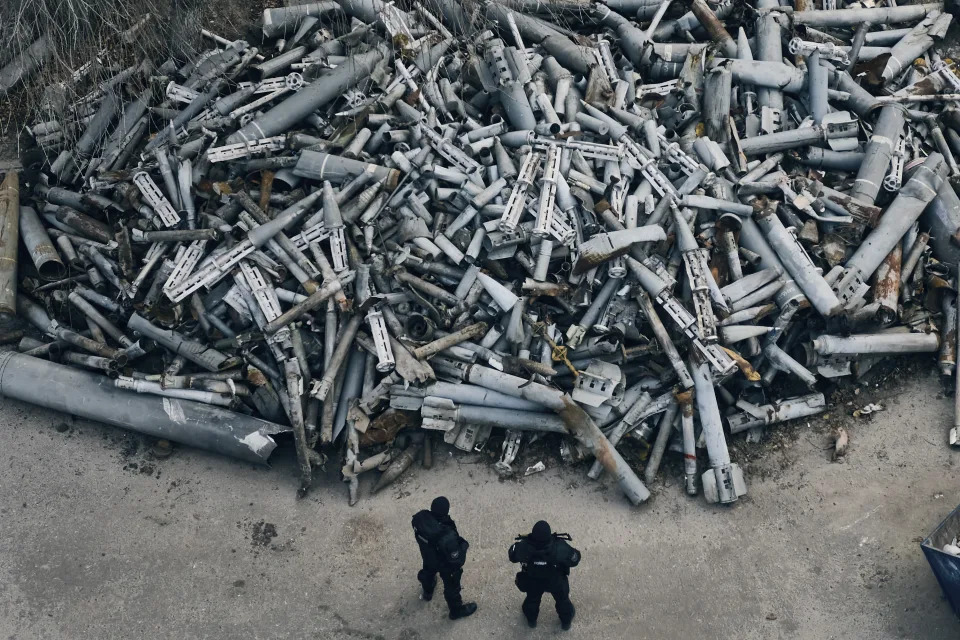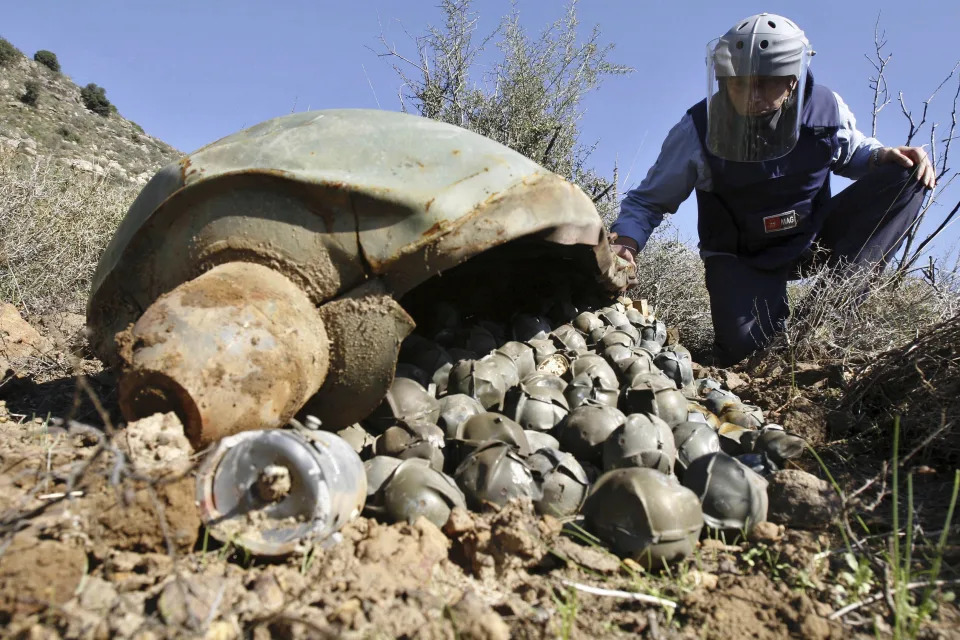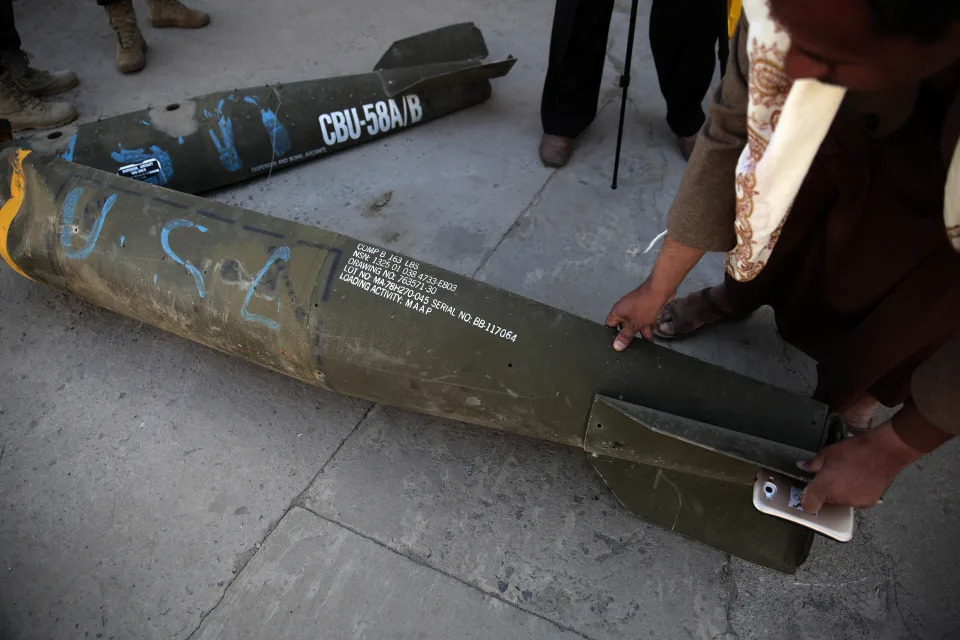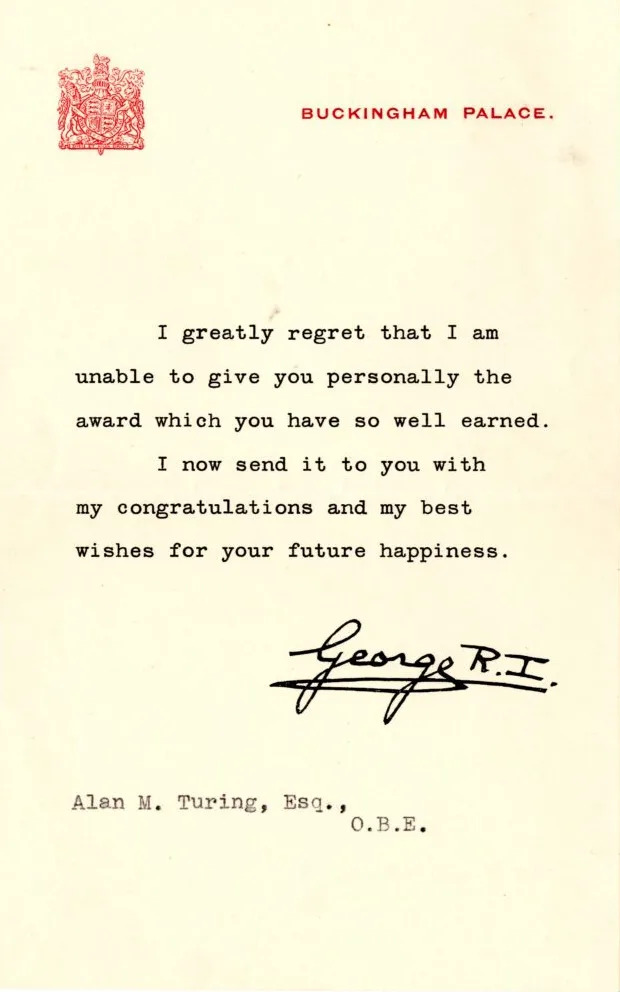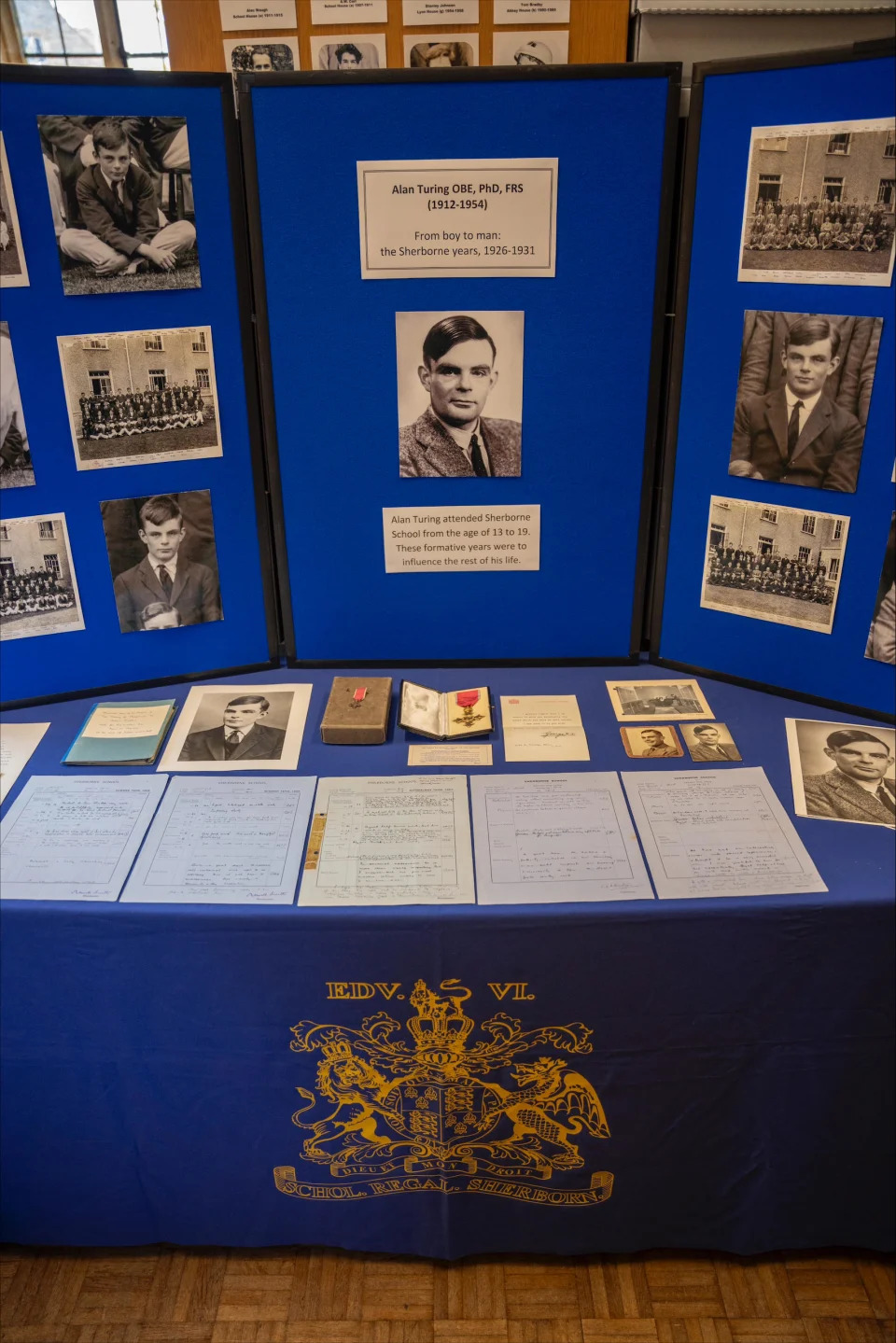Susan Selasky, Detroit Free Press
Mon, September 4, 2023
With a strike deadline looming, UAW President Shawn Fain told a cheering crowd of organized labor workers and supporters Monday at Detroit's annual Labor Day parade that “We are 10 days out and have a lot of work to do."
“The UAW is back in the fight and we are ready to stand united to win economic and social justice,” Fain said about ongoing contract negotiations with the Detroit Three
Meanwhile, on Monday at a Labor Day event in Philadelphia, President Joe Biden told reporters that he doesn't expect the UAW to strike any of the Detroit Three auto companies, as discussions intensify among autoworkers, union leaders, auto company executives and investors.
“No, I’m not worried about a strike until it happens. I don’t think it’s going to happen." Biden said, when asked about a potential auto strike.
When asked about Biden’s comments at Monday’s Labor Day parade, Fain said he was “shocked by that reaction.”
UAW President Shawn Fain talks to a crowd following the Labor Day parade Roosevelt Park in front of the Michigan Central Station in Detroit on Monday, Sept. 4, 2023.
“He must know something we don’t know,” Fain told reporters. “Maybe the companies plan on walking in and giving us our demands the night before. He’s on the inside of something I don’t know about. Our intent is not to strike. Our intent is to get a fair agreement. “
Labor Day returns
Monday's event was a return of the annual Labor Day Parade to downtown Detroit after a three-year pandemic hiatus. A message of solidarity, social and economic justice and workers’ rights was loud and clear amid those who marched and chanted.
This year's theme “Labor United Stronger than Ever!” comes amid current negotiations for a new, four-year contract, with the Detroit Three. The current contract expires at 11:59 p.m. on Sept. 14 and UAW autoworkers have already voted to authorize a strike if an agreement is not reached.
More: UAW files unfair labor charges against GM and Stellantis; Ford proposal tossed in trash
More: UAW President Shawn Fain responds to workers worried about pay loss during a strike
Thousands of organized labor members took to the streets and center stage in Corktown on Monday, celebrating American workers, solidarity and what they stand for on this Labor Day.
The parade kicked off at 9 a.m. on a hot, sunny morning starting on Michigan Avenue at Sixth Street. This year, the parade headed west on Michigan Avenue into Corktown instead of the usual trek to downtown Detroit.
As expected, there was a sea of those wearing red for solidarity, holding signs and chanting. Workers' shirts and placard signs included messages of “End Tiers” referencing the two-tiered pay system, “record profits, record contract” echoed by UAW members as they marched with fellow workers, families and children.
Among those leading the parade with Fain was Liz Shuler, AFL-CIO president, and U.S. Rep. Debbie Dingell, D-Ann Arbor.
Shuler said the workers are “fired up."
People chant while marching during the Labor Day parade along Michigan Avenue in Detroit's Corktown neighborhood on Monday, Sept. 4, 2023, to Roosevelt Park in front of the Michigan Central Station.
“They are fired up, they got us through this pandemic, they sacrificed and now they want their fair share,” Shuler said. “We are seeing it here with the UAW, we are seeing it with bakery workers, nurses and hotel workers all across this country. Working people are on the rise.”
Marching in the parade, Dingell called labor the “backbone of the American economy.”
“What’s going to happen here in the next two weeks is people recognizing that working men and women are the backbone of our economy and they need to be paid a fair and decent wage.”
The parade was made up of several unions including the UAW, Teamsters, state workers, building trades and others, marched west on Michigan Avenue in Corktown ending at Roosevelt Park with Ford’s Michigan Central Station in the backdrop.
More than a half dozen elected and union officials took the stage before a cheering crowd delivering messages of support for workers, workers' rights and solidarity. Those speaking included Dingell; Democratic Lt. Gov. Garlin Gilchrist; U.S. Sen. Debbie Stabenow, D-Mich.; U.S. Rep. Shri Thanedar, D-Detroit; U.S. Rep. Elissa Slotkin, D-Holly; U.S. Rep. Rashida Tlaib, D-Detroit; state Rep. Joe Tate, D-Detroit; Michigan Attorney General Dana Nessel and others.
Supporting workers
Teamster Nicholas Daly, 28, of Monroe, was joined by his wife, Lindsay, at the parade
“I’m here to support union members,” Daly, who works for Coca Cola said. “It means a lot to be part of the labor movement. The last time I had a job not in a union was in high school.”
Bob Wydra, a member of UAW Local 1284 at Stellantis’ Chelsea Proving Grounds, has been attending the parade since 2014.
“It’s especially important this year because it’s a contract year and gives us solidarity,” Wydra said. "It brings people and a sense of cohesiveness, like a pep rally.”
Teamster member and car hauler Darrell Buckner, of Lincoln Park, comes to the parade every year. “It shows solidarity and pride,” he said. His wife, Kirsten, and sons Darrell Jr. and Logan also attended.
Message to members
Fain delivered his much-repeated message that the automakers have seen record profits and workers deserve a fair share of social and economic justice. He noted that included $21 billion in the first six months of this year.
“Our workers deserve their share of equity in this and they are not getting it,” he said.
Fain also said that it’s not their intent to strike.
“Our intent is to get a fair agreement,” he said. There are three companies to bargain with and there are 10 days left to do it. “The goal is a fair and equitable agreement for our members. At the end of the day, if we are not there, there will be a strike.”
This article originally appeared on Detroit Free Press: UAW's Fain delivers message of fair contract at Labor Day parade
Biden says he thinks US auto workers' strike unlikely to happen
Trevor Hunnicutt
Mon, September 4, 2023

U.S. President Joe Biden leaves following services at St. Edmond's Catholic Church in Rehoboth Beach
By Trevor Hunnicutt
PHILADELPHIA (Reuters) -U.S. President Joe Biden said on Monday that he did not think workers at the nation's three large automakers were likely to go on strike, despite a looming contract deadline later this month.
KEY QUOTE
"I'm not worried about a strike," the Democratic president said on Monday as he arrived in Philadelphia ahead of a speech for the U.S. Labor Day holiday. "I don't think it's going to happen."
THE TAKE
Late last month, the United Auto Workers union said its members voted overwhelmingly in favor of authorizing a strike at the Detroit Three automakers if agreement is not reached before the current four-year contract expires on Sept. 14.
A strike by the UAW is not a certainty. But the substantial wage and benefit gains that UAW President Shawn Fain has demanded, and the intensity of the campaign the union has mounted, had some Detroit industry executives and analysts bracing for walkouts in September.
CONTEXT
* The National Labor Relations Board on Friday said it would open an investigation into UAW claims that General Motors and Chrysler parent Stellantis were not bargaining in good faith, claims that the automakers deny.
* Separately, Ford Motor said Thursday it had offered a 9% wage increase through 2027, far below the 46% wage hike being sought by the union.
* The UAW staged a 42-day strike against GM in 2019 before reaching a new contract.
(Reporting by Trevor Hunnicutt; writing by Kanishka Singh; editing by Jasper Ward and Rosalba O'Brien)
Biden faces increasing pressure to deliver ‘win-win’ EV transition amid union talks
UAW talks: Why the shift to EVs is such a big deal to workers
Akiko Fujita
·Anchor/Reporter
Mon, September 4, 2023
Throughout his presidency, Joe Biden has touted himself as the "most pro-union president in history."
That claim is being tested as the President juggles two priorities at the center of his economic policy: accelerating the transition to clean energy and creating well-paying, union jobs.
As the threat of a strike looms amid negotiations between the United Auto Workers union and major US automakers, the White House faces increasing pressure to deliver on its promise of better wages and benefits for workers at electric vehicle facilities.
On Thursday, the Department of Energy announced it would provide up to $12 billion in loans to help carmakers retrofit existing manufacturing facilities for EV production and encourage those factories to create high-paying union jobs. The Energy Department stressed that the priority for federal grants would be given to "projects that are likely to retain collective bargaining agreements and/or those that have an existing high-quality, high-wage hourly production workforce."
"Under Bidenomics building a clean energy economy can and should provide a win‑win opportunity for auto companies and unionized workers," Biden said in a prepared statement.
Mary Barra, CEO of General Motors, stands with President Joe Biden during a tour of the Detroit Auto Show, Wednesday, Sept. 14, 2022, in Detroit. (Evan Vucci/AP Photo)
The announcement, coming just weeks away from the Sept. 14 deadline for UAW and Detroit automakers to reach a new contract agreement, points to the delicate balance the administration is attempting to maintain between keeping its promise to the industry’s 150,000 unionized employees and accelerating the transition to clean energy.
UAW’s president Shawn Fain has publicly called for GM (GM), Ford (F), and Stellantis (STLA) to hike pay by 46%, return to traditional pensions, and implement a 32-hour workweek.
Some Wall Street analysts estimate the wage increases alone would increase the cost of EVs by roughly $1,500 to $2,000, creating a headwind to mass adoption and putting American carmakers behind foreign automakers that operate in "right to work" states to avoid unionization.
EV leader Tesla (TSLA) is the only American automaker that is not represented by a union.
"The UAW is certainly looking for all of the opportunities that as old school manufacturing of [internal combustion engine vehicles] closes down or shifts, that they have a seat at the table regardless of where those plants are opened," David Undercoffler, editor in chief at Autolist, said.
United Auto Workers Union president Shawn Fain speaks to members of Local 862 during practice pickets in Louisville, Ky., Thursday, Aug. 24, 2023. (Timothy D. Easley/AP Photo)
UAW’s demands point to a larger fear among auto workers about job security, as a move towards an all-electric future prompts a retooling of decades-old plants.
The absence of gas engines and transmissions makes EVs much simpler to manufacture, according to Undercoffler, triggering concerns about the need for fewer workers and fewer hours.
In its most recent round of layoffs, Ford attributed the cuts to a growth plan largely focused on a transition to electric, saying: "Delivering on the plan includes adjusting staffing to match focused priorities and ambitions, while raising quality and lowering costs."
"The critical issue in that transition is going to be wages," said Seth Harris, a professor at Northeastern University who served as acting secretary of labor under President Barack Obama. "Can workers earn the same quality wages in an electric vehicle battery plant that they were working?"
Robert Bruno, a professor of labor and employment relations at the University of Illinois, said UAW is well positioned to push for aggressive demands, largely because of the scale of investments going into the clean energy transition, stemming from Biden's landmark climate legislation, the Inflation Reduction Act.
Last month, the union successfully pushed to ratify an interim agreement at a GM factory that manufactures Ultium battery cells that immediately raised wages by $3 to $4 an hour.
"This is probably when their leverage is at its greatest because the domestic manufacturers really don't want to be shut down," Bruno said. "There's too much federal money that's available. There's too much investment that is now pouring into the United States."
The UAW has maintained that pressure on the president as well, holding back its endorsement of Biden’s reelection, citing concerns around electric vehicle policy. And there are signs that pressure may be spreading beyond Detroit now.
On Monday, a coalition of labor unions and civil rights groups launched a pressure campaign targeting Hyundai’s EV plant and suppliers, calling on the South Korean automaker to "enshrine high-road commitments to workers and their communities in an enforceable agreement."
"I think there will be pressure on all of these companies, particularly using the leverage of the electric vehicle credits in the Inflation Reduction Act to push them to provide good quality union jobs to their workers," Harris said.
Akiko Fujita is an anchor and reporter for Yahoo Finance. Follow her on Twitter @AkikoFujita.
Auto Strike Looms, Threatening to Shut Detroit’s Big 3
Neal E. BoudetteSun, September 3, 2023

An assembly line for the Ford F-150 Lightning electric truck in Dearborn, Mich. on Jan. 25, 2022. (Brittany Greeson/The New York Times)
The United Auto Workers union and the three Detroit automakers have less than two weeks to negotiate a new labor contract, and a strike of some sort seems increasingly likely.
The union’s president, Shawn Fain, has primed rank-and-file members to be prepared to walk off the job if the union’s long list of demands for improved wages and benefits are not met.
A strike against one of the companies, especially a prolonged stoppage, could send an economic jolt through several Midwestern states and crimp the profits of General Motors, Ford Motor or Stellantis. GM workers walked out for 40 days in 2019 before reaching an agreement.
A strike against all three — a step the union has never taken but one Fain has said he is willing to call for this year — could have a noticeable impact on the broader U.S. economy.
“If that happens, even a short strike would impact economies throughout Michigan and across the nation,” said Patrick Anderson, the CEO of the Anderson Economic Group in East Lansing, Michigan.
The talks are playing out as automakers are spending tens of billions of dollars to transition to electric vehicles, which require fewer workers to assemble than traditional gasoline-powered cars and trucks. The terms of the new contract will determine how both autoworkers and the companies fare in an EV-centric industry.
At the same time, significant wage and benefit gains could provide a tail wind for a union movement that has been gaining strength across several industries.
There are political stakes as well. President Joe Biden has declared that “the UAW deserves a contract that sustains the middle class” and has named a White House liaison to the union and the automakers. But the UAW has withheld an endorsement of his reelection bid so far, partly because of concern over the union’s share of EV-related jobs created with federal subsidies.
An agreement before the contracts expire Sept. 14 is still possible, and talks could continue beyond that date without a walkout. But Fain has repeatedly said he views Sept. 14 as a deadline — the day a strike could begin. He was elected to the UAW presidency last year as an insurgent, ousting the incumbent on a vow to take a more combative and confrontational approach in the talks than his recent predecessors.
“President Fain has declared war, and that usually means there’s going to be a battle, and that battle would be a strike,” said Sam Fiorani, the vice president of global vehicle forecasting at Auto Forecast Solutions, a market researcher. “The UAW leadership is in a position now where they have to prove to the members that they are fighting for them, so it’s pretty unlikely there won’t be a strike.”
The auto industry as a whole, including foreign-owned companies with operations in the United States, makes up about 3% of the country’s gross domestic product. A 10-day strike against the three Detroit automakers would result in total wage losses of $859 million and manufacturers’ losses of $989 million, according to estimates by Anderson’s firm.
In August, Fain sent each company a list of demands, including higher wages, improved benefits, a resumption of regular cost-of-living wage bumps to ward off the impact of inflation and an end to a wage structure that leaves newer hires making one-third less than veteran workers. Fain suggested as much as a 40% wage increase, noting that the CEOs of each of the companies had their compensation packages rise substantially in the last four years.
He also called for contract provisions that would require the automakers to pay workers to do community service if their plant closes, describing it as a way to deter the companies from shuttering factories and to protect towns and local economies from being ravaged by the loss of a major employer.
“The manufacturers can absolutely afford some of those demands, but the more they get, the less competitive the companies are going to be,” Fiorani said.
In a video message streamed on Facebook on Thursday, however, Fain said the union and the automakers remained far apart. Ford, he said, offered wage increases and other provisions that were “insulting” to the UAW.
In a statement, Ford said it had offered a 9% wage increase and one-time lump-sum payments that, combined, would increase a worker’s income by 15% over the four-year contract. Fain said lump-sum payments helped but did not improve a worker’s income over a long period.
The UAW and Ford are also at odds over profit-sharing bonuses, the use of temporary workers, cost-of-living wage increases, retiree health care and several other matters.
Fain said that GM and Stellantis had not provided counteroffers to the union’s proposals and that the UAW had filed a complaint with the National Labor Relations Board contending that the two companies were not negotiating in good faith.
“I know this update is infuriating, and believe me when I say I’m fed up,” he said. “Our goal is not to strike. Our goal is to bargain a fair contract, but if we have to strike to win economic and social justice, we will.”
GM said it was “surprised by and strongly refutes” the charges in the NLRB complaint. “We have been hyper-focused on negotiating directly and in good faith with the U.A.W. and are making progress,” Gerald Johnson, GM’s vice president of global manufacturing, said in a statement.
Stellantis was “disappointed to learn that Mr. Fain is more focused on filing frivolous legal charges than on actual bargaining,” the company said in a statement. “We will vigorously defend this charge when the time comes, but right now, we are more focused on continuing to bargain in good faith for a new agreement.”
In recent weeks, workers have organized several dozen rallies and other gatherings to prepare for picketing. “I think the membership is energized,” said Christine Bostic, a battery tester at a GM electric vehicle plant in Detroit. “The facts are on our side. If it comes to a strike, I’m ready for that.”
To soften the impact of a stoppage, the union has amassed a strike fund of $825 million. It plans to pay striking workers $500 a week and cover their health insurance premiums while they are out of work.
In recent days, Fain joined the union’s negotiating teams in their talks with each of the automakers, an unusual step. Normally, the UAW president does not take a direct role until the final days or hours of negotiations.
On Wednesday, he took part in discussions with Stellantis, where tensions between the two sides have been high. When Stellantis responded to Fain’s demands with a list of cost concessions it wanted from the union, Fain took to Facebook to denounce them, dropping the document into a wastebasket.
Decades ago, when the UAW had more than 1 million members and the Big Three — GM, Ford and Chrysler, now part of Stellantis — had almost no foreign competition, a strike by the union could shut down a significant portion of the U.S. economy.
Today, the union is much smaller. GM, Ford and Stellantis employ about 150,000 UAW workers, and those companies make only a little more than 40% of the cars and trucks sold in the U.S. market.
But the union entered this year’s talks in a much stronger negotiating position than it had in years. In the past, the Detroit companies were struggling badly against foreign rivals that operate nonunion plants in the South, like Toyota and Honda, and had a significant cost advantage. In most of the last several contracts, GM, Ford and Stellantis had to get concessions on wages and benefits to survive.
Over the last 10 years, however, all three companies have rung up record profits, thanks in part to the concessions they won from the union as well as the shift in consumer preferences to high-margin trucks and large SUVs.
In the first half of this year, Ford made $3.7 billion and GM made $5 billion. Stellantis reported profits of 11 billion euros (about $11.9 billion).
In the past, the UAW has chosen one company — it was GM four years ago — as the “target” to focus on in the talks. Fain has said the union could target all three companies this time around, but many analysts think the union will eventually choose Stellantis. In addition to the strains between the company and the union, their talks involve a plant in Belvidere, Illinois, that Stellantis has idled and that the union wants the company to reopen.
Getting Stellantis to reopen the plant is a critical task for Fain. Four years ago, GM closed a plant in Ohio, and the UAW failed in its efforts to push the company to reopen it. In his campaign for the presidency, Fain promised members that his tougher approach would prove successful this time.
The union could get a hand in this battle from the federal government. On Thursday, the Energy Department said it had made $2 billion in grants and $10 billion in loans available to auto companies to convert existing factories that build gasoline-powered cars and trucks into plants that produce hybrid and electric vehicles.
Stellantis, like GM and Ford, aims to introduce several more electric models over the next few years and will probably have to retool some plants to make them. It is already building a battery plant in Indiana for its EV push.
Fiorani suggested that Stellantis could decide to overhaul the Belvidere plant to make electric models. “Stellantis could find a product to go in there,” he said. “For the UAW to truly win something, though, it has to be electric vehicles that Stellantis would plan on making for several years.”
c.2023 The New York Times Company
